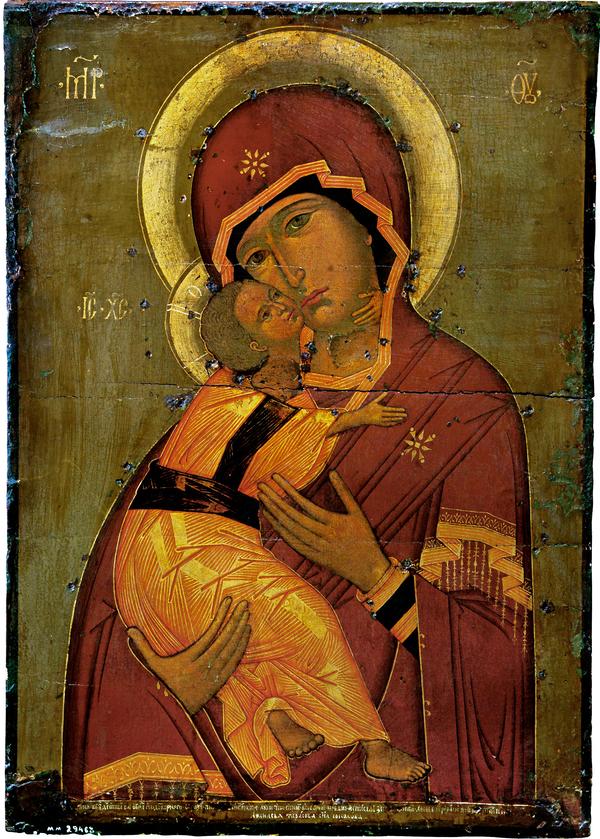The icon was painted by Afanasy Ryazantsev in 1692. It became the main Theotokos icon of Annunciation Cathedral in Murom. Afanasy Ryazantsev was the denominator of the atelier ward of czarinas and czarevnas. He created the icon at the request of the Afanasy Sokolov, merchant of the Moscow Gostiny Hundred (special and privileged social category in Russia of 16th – 18th centuries). The authorship is proved by the preserved signature on the lower field of the icon. Another image of the Virgin Mary of Vladimir was painted by Afanasy Ryazantsev a year earlier, in 1691. It is still kept in the church of Elijah the Prophet in Moscow.
The image of the Virgin Mary on the icon by Afanasy Ryazantsev continues the tradition of the Byzantine icons of the 12th – 17th centuries. When the icon painter executed his replica, he was guided by the miraculous image of the Mother of God and sought to convey its artistic features. The legendary story of the creation of the image of the Virgin Mary by Luke the Evangelist is shown on a separate board in four marginal scenes.
First two scenes depict how Luke creates the image of the Mother of God and shows it to Her. These scenes are widely met in Russian art. It applies to both separate icons and border scenes of the miracles on the Virgin Mary images. These two scenes are based on the Christian tradition of venerating Luke the Evangelist as the creator of intravitam images of the Blessed Virgin. The legend appeared no later than the 6th century. At the beginning of the 8th century, St. John of Damascus used this story as an important argument in a dispute with the iconoclasts.
Third and fourth scenes show the legend about the acheiropaeic image of the Virgin Mary. The apostles asked the Mother of God to deliver her benediction to the temple they built in Lydda near Jerusalem. The last scene shows apostles’ and people’s hyperdulia to the acheiropaeic image of the Mother of God that appeared in the temple.
The icon also has a separate insert board, which was made in 1709. It indicates that the icon was a contribution of Afanasy Sokolov, a merchant of the Moscow Gostiny Hundred, to the Annunciation Monastery:
The image of the Virgin Mary on the icon by Afanasy Ryazantsev continues the tradition of the Byzantine icons of the 12th – 17th centuries. When the icon painter executed his replica, he was guided by the miraculous image of the Mother of God and sought to convey its artistic features. The legendary story of the creation of the image of the Virgin Mary by Luke the Evangelist is shown on a separate board in four marginal scenes.
First two scenes depict how Luke creates the image of the Mother of God and shows it to Her. These scenes are widely met in Russian art. It applies to both separate icons and border scenes of the miracles on the Virgin Mary images. These two scenes are based on the Christian tradition of venerating Luke the Evangelist as the creator of intravitam images of the Blessed Virgin. The legend appeared no later than the 6th century. At the beginning of the 8th century, St. John of Damascus used this story as an important argument in a dispute with the iconoclasts.
Third and fourth scenes show the legend about the acheiropaeic image of the Virgin Mary. The apostles asked the Mother of God to deliver her benediction to the temple they built in Lydda near Jerusalem. The last scene shows apostles’ and people’s hyperdulia to the acheiropaeic image of the Mother of God that appeared in the temple.
The icon also has a separate insert board, which was made in 1709. It indicates that the icon was a contribution of Afanasy Sokolov, a merchant of the Moscow Gostiny Hundred, to the Annunciation Monastery:



